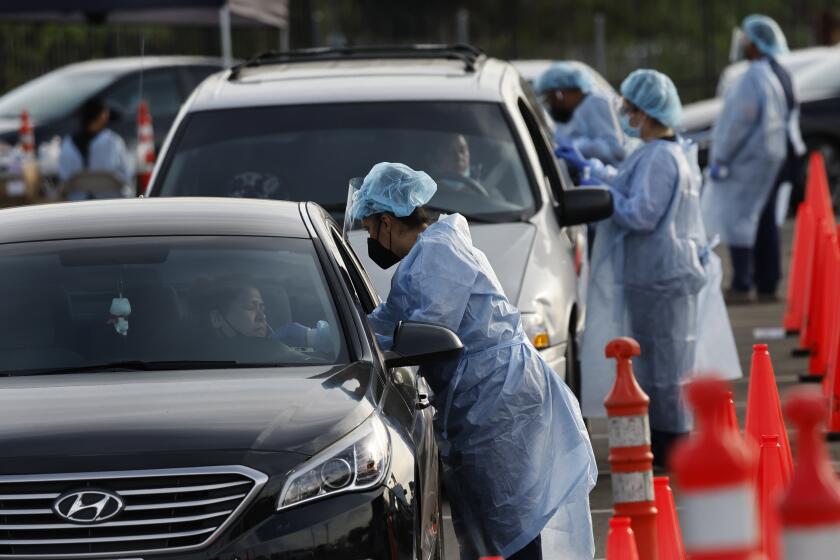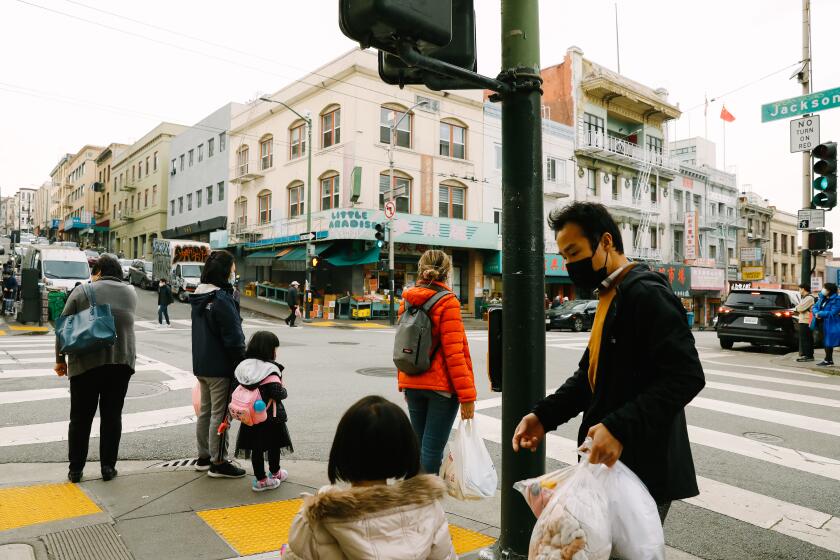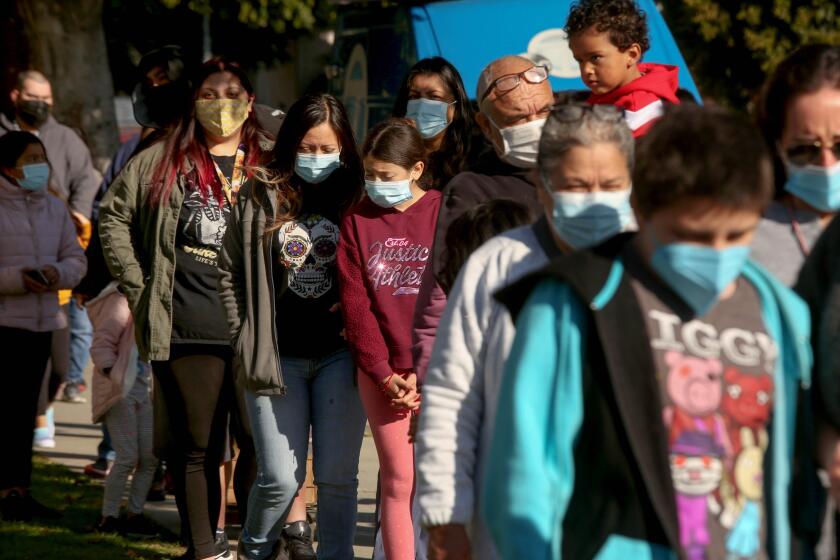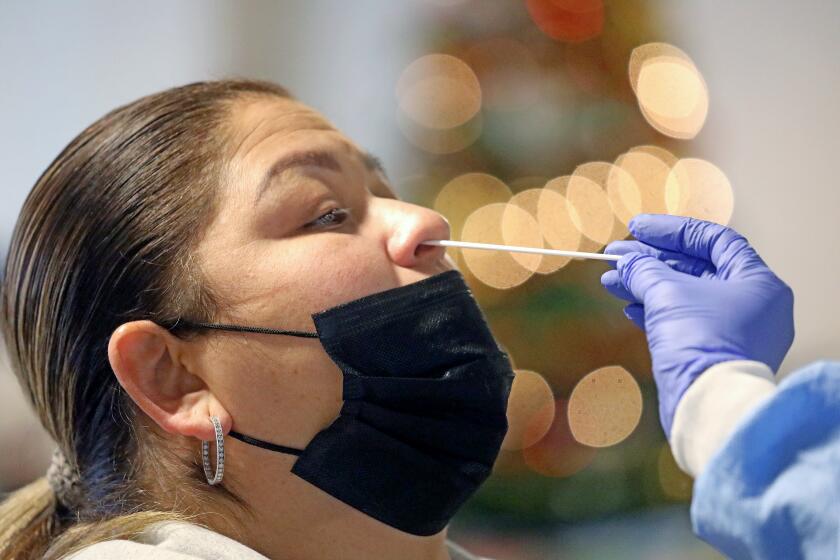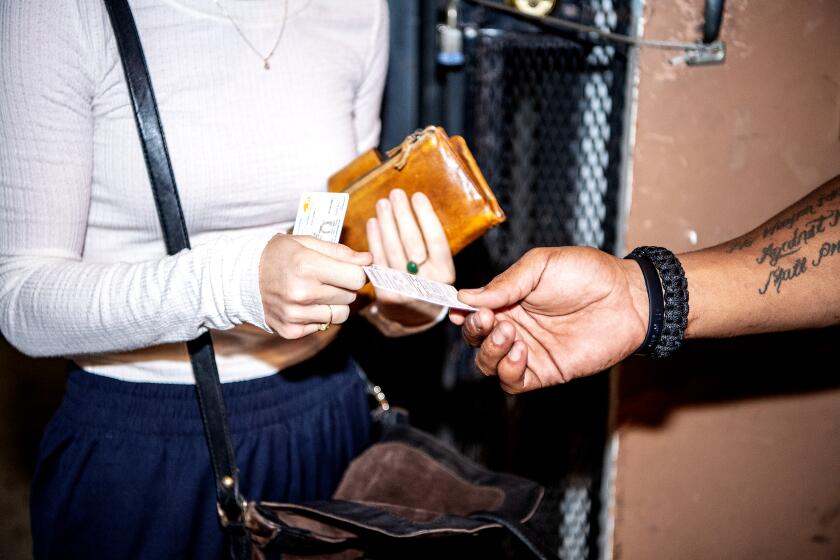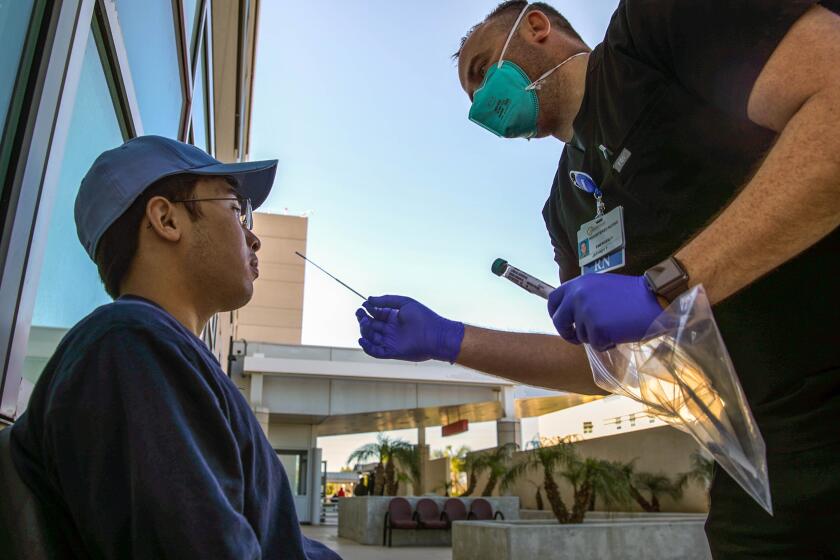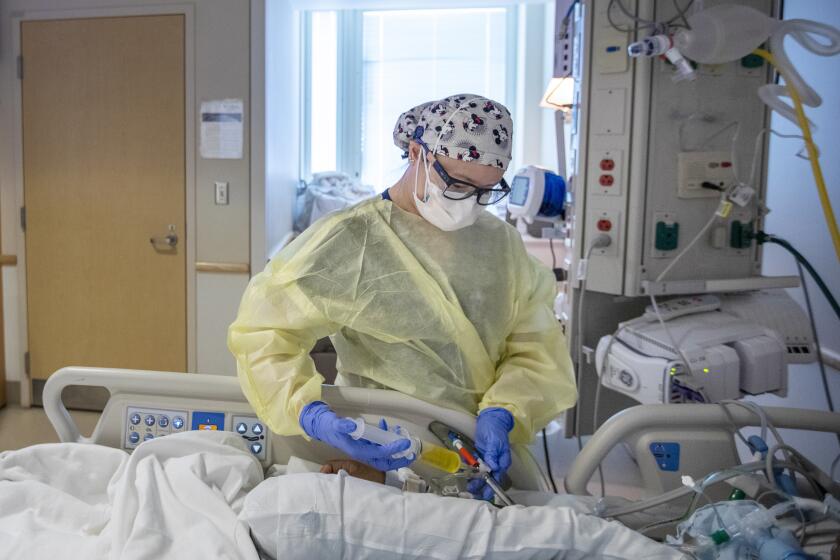Rams-49ers football, Lunar New Year pose new COVID-19 challenge for California
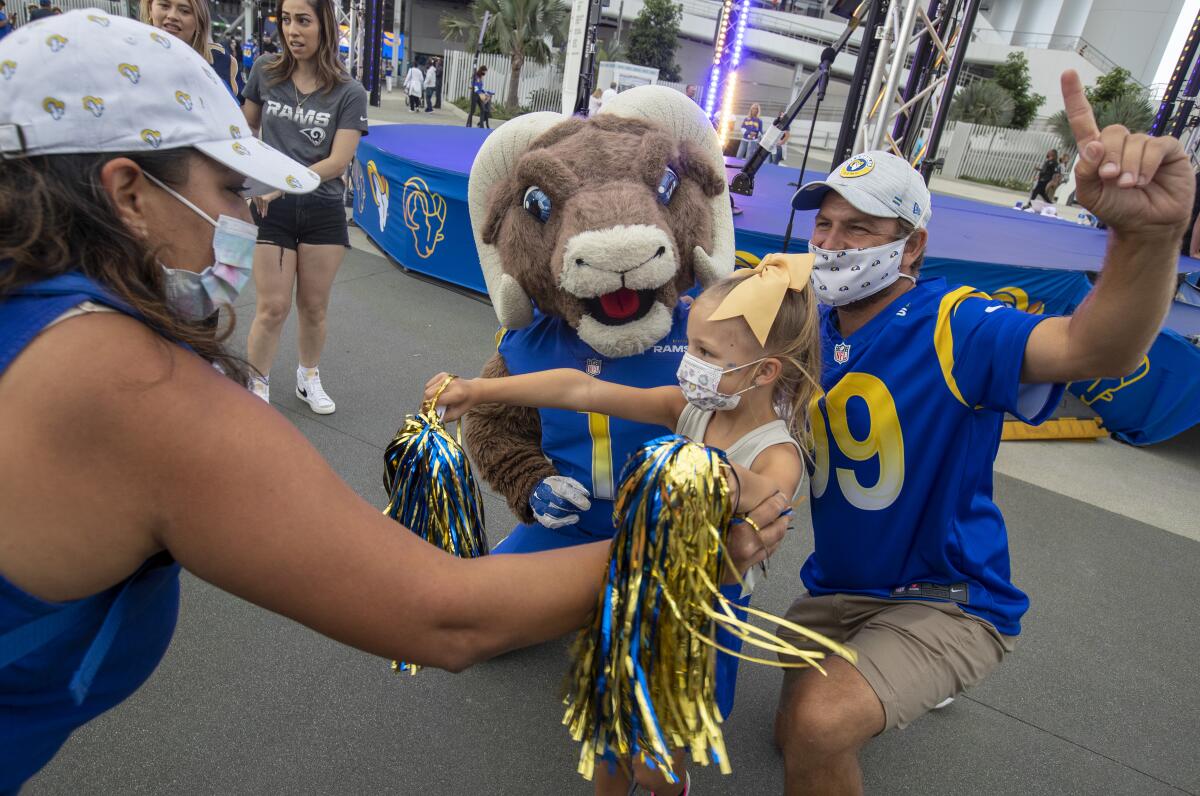
- Share via
It was a thrilling moment for Los Angeles sports fans: The Dodgers and Lakers both winning world championships within weeks of each other in the fall of 2020.
But health officials would later suggest the revelry that marked those teams’ paths to victory carried an unintended consequence: helping keep the COVID-19 pandemic smoldering before it exploded during the holiday season into a winter surge.
Now, California is on the downslope of yet another coronavirus surge as it enters another season of celebration. Numerous family gatherings and community events are scheduled to mark the Lunar New Year next week. And the L.A. Rams and the San Francisco 49ers will duke it out at SoFi Stadium on Sunday with a trip to the Super Bowl — scheduled in Inglewood two weeks later — on the line.
But as California’s experience illustrates all too clearly, celebration without caution could wind up prolonging a pandemic already set to enter its third year.
“We are starting to see the decline. If we want to continue to see a decline, we’ve got to follow some common-sense practices,” said L.A. County Public Health Director Barbara Ferrer. “And if we’re going to be gathering, hosting or attending football-viewing parties, we have to do it sensibly.”
Certainly, the risk of coronavirus transmission is not as grave as it was a couple of weeks ago. Important metrics — including the numbers of daily new infections and the test positivity rate — have fallen from the all-time highs seen earlier this month, and California’s own modeling estimates transmission is probably decreasing across the state.
California is averaging about 94,000 new coronavirus cases a day over the last week, down nearly 25% from the Omicron peak of 123,000 cases a day about two weeks ago. Both California and L.A. County, however, are still reporting a coronavirus case rate double their respective peaks from last winter.
Those who are younger, don’t have underlying health conditions and, importantly, are vaccinated and boosted can be reasonably confident that they’re well-protected against the worst COVID-19 has to offer.
Still, some health officials are suggesting people avoid higher-risk gatherings to reduce opportunities for the highly infectious Omicron variant to spread.
“What I do expect, unfortunately, is, after big events like this, we will see a slight increase in cases — hopefully not too high,” said Dr. Regina Chinsio-Kwong, a deputy health officer for Orange County. “And I just hope to not hear any more family or friends or neighbors telling me that another person is hospitalized. That’s my hope, as a physician, and a friend, and a family member.”
California has reported more than 8 million coronavirus cases since the pandemic began, or 1 out of every 5 residents testing positive at some point.
Along with Sunday’s NFC title clash, which many may choose to watch in a crowded bar or at an indoor party, Lunar New Year’s Eve this year falls on Monday — and the weeks around that event are often seen as a time for reunions and dinners in Asian American communities, involving multiple generations of family.
A number of Lunar New Year events are also scheduled to go forward this year, including the Tet Festival on Feb. 5-6 at the O.C. Fair & Event Center in Costa Mesa. All activities for the Tet Festival, which was canceled last year, are held outdoors.
For some people, especially among those at high risk for disease, it may be prudent to postpone such gatherings and events during a time of exceptionally high viral transmission, Ferrer said.
“It’s a risk gradient at this point,” she said during a briefing Thursday. “And that’s how we’re approaching all of the activities we do — assessing our own personal risk and the risk to others for that activity and then layering protections as appropriate.”
She added, however, that she believes those attending such gatherings — or watching this weekend’s game in person — can do so with reduced risk with sensible precautions.
The new rules, which take effect Tuesday, come as the Omicron surge is flattening after weeks of record-setting infections.
Specific to SoFi Stadium, Ferrer noted that L.A. County has for months required patrons at venues of that size to show they’ve either been vaccinated or have recently tested negative for the coronavirus. Most of the fans attending games at SoFi Stadium this season have been fully vaccinated, Ferrer said, and there has been no sign of superspreading events at the venue.
“I have confidence that, because for months now we have been open and layered in protections, that people will continue to be cautious, to take advantage of all of the strategies that are available to keep themselves and the people they love safe, and that the partnership with both the NFL and SoFi Stadium gives us a good opportunity to hold an event with as much safety as possible,” she said.
Those at lower risk for severe illness could still decide to gather and may end up being fine, but officials say they should still take steps to reduce risk, such as watching the game outdoors, keeping parties small, wearing a mask and maintaining physical distance as much as possible.
“If you can’t move the TV outside ... move the food outside,” Ferrer said.
Transmission risk can also be reduced — though not eliminated — by having people take rapid tests just before gathering. However, that’s not foolproof, as there is a blind spot in which a rapid test may not detect a person’s first couple of days of contagiousness.
In general, tests are able to reveal an Omicron infection, but enough virus needs to have reproduced and appear at sufficiently high levels in the nose or saliva to be detectable, health officials say.
If people do decide to eat indoors with people outside of their household, Chinsio-Kwong encouraged them to stay masked as much as possible when not eating or drinking.
“But I realize that not everyone’s going to follow that guidance, and everyone will just have to decide if they want to take the risk of getting sick,” she said.
Delaying a Lunar New Year gathering would also provide more time for case rates to fall, eroding some of the risk of spread and exposure.
Those who do gather with people from different households, especially indoors, should have a game plan for what to do should they become infected — and be clear-eyed about what they’ll need to do if they get sick, officials say. That includes being prepared to go into isolation when infected, telling your close contacts of your infection, and quarantining if you’re exposed to someone who’s infected and you’re not vaccinated or boosted.
Fake COVID-19 testing sites are popping up in Los Angeles and Orange counties. Here’s what to look out for.
People can be highly contagious yet show no signs of illness. It’s more likely that unvaccinated people will get infected, but vaccinated people can still contract and spread the coronavirus.
“We’re going down, but there’s still a lot of virus,” Dr. Peter Chin-Hong, a UC San Francisco infectious-disease expert, said of coronavirus case rates, and there’s a chance that people will let their guard down too quickly and get infected.
The rate of transmission is still high enough that, for this weekend, Chin-Hong said he probably wouldn’t be inclined to dine inside a small restaurant with poor ventilation or visit an indoor bar.
Though there’s hope Omicron may wane as quickly as it spiked, an experience seen in some other areas where the variant struck earlier, health officials say it will still take time for coronavirus transmission to fall to far-more-manageable levels.
In some places, “the downslope isn’t quite as steep as the upslope. In other words, our way out may be a bit more of a meandering course — we may not just come out of it as as quickly as we came into it,” said Dr. Sara Cody, the Santa Clara County public health director and health officer.
L.A. has not cited any businesses for failing to check customers’ COVID vaccination status, opting for a grace period that runs out in a few days.
Cases are just one consequence of continued high transmission, however. Hospitals are still being asked to care for high numbers of patients while simultaneously navigating their own pandemic-related staffing shortages. As of Wednesday, 15,015 coronavirus-positive patients were hospitalized statewide — down slightly from a week ago, but still more than quadruple the pre-Omicron census.
And even though the percentage of infected people who are ultimately dying from COVID-19 this winter is less than in previous waves, the total number of reported COVID-19 deaths is rising fast. Over the last week, California reported an average of 150 deaths a day, exceeding the peak of 135 seen during last summer’s Delta surge.
Among those Chin-Hong is most concerned about suffering severe disease are older people who haven’t received a booster shot and who have weakened immune systems.
Chinsio-Kwong said there also may still be as-yet undetermined consequences from an asymptomatic or mild Omicron infection.
“My concern is that it may increase chronic conditions at an earlier age, it may result in more autoimmune illness — we are seeing some studies with that,” she said during a briefing Wednesday. “It’s not a benign illness.”
Those who end up in the hospital, she added, “are the ones who are not yet fully vaccinated, or they’re just older in age and they’re more vulnerable because they have chronic conditions, or they’re younger in age and were not yet eligible for vaccine.”
The Omicron surge has peaked, rather unevenly, in California. But there’s one wrinkle — the emergence of a subtype called BA.2.
With earlier variants, it has been suggested that being outside carried such a low risk of infection that it was essentially completely safe to gather in such settings. But with Omicron still circulating widely, Dr. Kirsten Bibbins-Domingo, chair of UC San Francisco’s Department of Epidemiology and Biostatistics, said she doesn’t think that’s necessarily the case anymore.
“In the past, I think we messaged: You’re completely safe if you’re outdoors. I don’t think that’s the right message right now,” she said earlier this month. “I think we are no longer in an environment where we say any venue is fully safe.”
During the height of the Omicron surge, the odds were that someone among a family gathering of 20 people was infected.
“And those people sitting together for several hours with each other — even outdoors — the chance of transmission is there. And if there’s somebody in that group, for whom you want there to be zero risk that they come down with Omicron, like your elderly matriarch of the family, then the safest thing is not to have that event,” Bibbins-Domingo said.
There’s also no way to guarantee that even a vaccinated and boosted person won’t come into a gathering with a breakthrough infection that may have evaded detection by a rapid test, “because that’s how much virus there’s around right now,” Bibbins-Domingo said.
An additional 91 COVID-19 deaths were reported in L.A. County on Wednesday, the second-highest daily total of the Omicron surge. One of the deaths was a 15-month-old.
Knowing that emergency rooms remain very busy, she said it’s prudent for people to take precautions for a limited period of time until the surge eases further.
“Everyone should do their part to try to make sure that that they’re not contributing to the overall burden on the healthcare system,” she said.
Some people may decide that connecting by video chat for the Lunar New Year may be a better idea this year, or meeting up briefly but keeping masks on to protect the most vulnerable, said Dr. Robert Kim-Farley, a UCLA epidemiologist and co-author of the book “Public Health Emergencies.” Families that decide to hold gatherings may decide to place members of each household at different tables.
“You’re just going to have to make your own decision as to where you lie on this continuum of risk versus benefit: the risk of potentially coming down with COVID, the benefit of being together as a family — you have to decide where you are on that risk-benefit curve,” Kim-Farley said.
More to Read
Sign up for Essential California
The most important California stories and recommendations in your inbox every morning.
You may occasionally receive promotional content from the Los Angeles Times.
